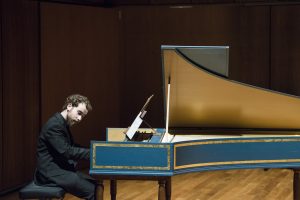PRENOTAZIONE OBBLIGATORIA (anche via whatsapp) al 339.27.48.814
o via email: amkarljenkins@gmail.com
In collaborazione con il ROMA FESTIVAL BAROCCO
TROISIEME LIVRE DE PIECES DE CLAVECIN
COMPOSE PAR MONSIEUR COUPERIN
Dix-septième Ordre
La Superbe ou La Forqueray
Les Petits Moulins a vent
Les Timbres
Courante
Les Petites Chrémieres de Bagnolet
Quinziéme Ordre
La Regente ou La Minerve
Le Dodo ou L’amour au Berceau
L’evaporée
La Douce, et Piquante
Les Vergers fleuris
La Princesse de Chabeüil ou La Muse de Monaco
Dixhuitiéme Ordre
Allemande La Verneüil
La Verneüilléte
Sœur Monique
Le Turbulent
L’atendrissante
Le Tic-Toc-Choc ou Les Maillotins
Le Gaillard-Boiteux
Quatorziéme Ordre
Le Rossignol en amour – Double du Rossignol
La Linote éfarouchée
Les Fauvétes Plaintives
Le Rossignol Vainqueur
Le Carillon de Cithére
Le Petit-Rien
Diego Ruenes Rubiales, clavicembalo J. H. Hemsch
Ingresso 12€/15€ (per un sostegno in più)
To speak of the music of François Couperin is to speak of the culmination of the French harpsichord school. The four volumes of Pièces de Clavecin by F. Couperin (1713, 1717, 1722 and 1730) contain more than two hundred twenty pieces for harpsichord, arranged in 27 Ordres, where we find mostly descriptive pieces, which according to his own words, are “espèces de portraits” (kind of portraits). These pieces can be organized into Rondeau Pieces, Dances and Binary Pieces.
François Couperin’s Troisiéme Livre de piéces de Clavecin consists of 44 pieces, arranged in 7 Ordres. Couperin hopes this book will appeal “to lovers of his works (…) at least as much as the two volumes that preceded it.” Although in front of them, he also affirms his demands as a musician: “Therefore, I declare that my pieces must be interpreted as I wrote it”.
Couperin was fifty-four years old at the time of publication and had published nothing since the Deuxiéme Livre (1717), except for the second edition of “L’Art de toucher le clavecin”.
The picturesque imagery is favored in this book by the titles (inspired by birds, plants, fields,…) and is accompanied by an exploration of the keyboard treble and a particular search for the timbral characteristics of the instrument (Le Carillon, Les Timbres, Le Tic-Toc-Choc) .
Although we only find one Courante with such a title, many pieces preserve the “characters of the dance”, thus finding Allemandes (La Superbe ou La Forqueray, Allemande La Verneüil, Les Graces incomparables ou la Conti) or Gigues (Le Rossignol vainqueur, Le Gaillard Boiteux).
 Spanish harpsichordist Diego Ruenes Rubiales (1990. Oviedo) began his musical studies at age six in Oviedo, Asturias. Studying with Luisa Cambiella, he finished the Piano intermediate studies at the Conservatorio Profesional de Música de Oviedo, obtaining the “Final Prize”. He completed a Bachelor on Piano at the Conservatorio Superior de Música “Eduardo Martínez Torner” del Principado de Asturias with Francisco Jaime Pantín, finishing his studies with the highest mark and with “Extraordinary Final Prize Ángel Muñiz Toca”.
Spanish harpsichordist Diego Ruenes Rubiales (1990. Oviedo) began his musical studies at age six in Oviedo, Asturias. Studying with Luisa Cambiella, he finished the Piano intermediate studies at the Conservatorio Profesional de Música de Oviedo, obtaining the “Final Prize”. He completed a Bachelor on Piano at the Conservatorio Superior de Música “Eduardo Martínez Torner” del Principado de Asturias with Francisco Jaime Pantín, finishing his studies with the highest mark and with “Extraordinary Final Prize Ángel Muñiz Toca”.
Diego started his Harpsichord and early music studies with Aarón Zapico and Jorge López Escribano at the Conservatorio Superior de Música “Eduardo Martínez Torner” del Principado de Asturias, where he finished the Bachelor studies with a first class degree with honours and as the winner of the “Extraordinary Final Prize Ángel Muñiz Toca”.
He moved to The Netherlands in 2014, where he earned a Master diploma with distinction in Harpsichord and Basso Continuo at the Koninklijk Conservatorium The Hague, with Professors Jacques Ogg, Kris Verhelst, Siebe Henstra and Patrick Ayrton.
He has taken part in masterclasses and courses with Christophe Rousset, Pierre Hantai, Francesco Corti, Wilbert Hazelzet, Ashley Solomon, Barbara Willi, Silvia Márquez, Enrico Gatti, Frank de Bruine, Philippe Pierlot, Pascal Bertin, among others.
Diego Ruenes has performed all over the world (Spain, The Netherlands, Belgium, France, Germany, Italy, Portugal, Latvia, Canada, Hong Kong), as a soloist and with different ensembles in places like the Notre Dame Cathedral in Paris (France), the Het Loo Palace (The Netherlands), De Doelen in Rotterdam (The Netherlands), the Lunenburg Academy (Canada), L’Auditori in Barcelona (Spain), Teatro Pérez Galdós in Las Palmas de Gran Canaria (Spain), Oratorio del Gonfalone in Rome (Italy) and the Palazzina Liberty in Milano (Italy), among others.
His master research “La Courante Françoise. Historically Informed Performance of the French Courante for Harpsichord during the second half of the seventeenth century following the criteria obtained from the Baroque Dance” has been published by the Research Catalogue, an international database for artistic research.
He holds a degree from Oviedo University in History of Art.